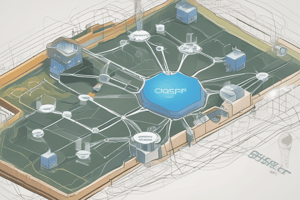Podcast
Questions and Answers
What is the first state in the OSPF neighbor adjacency process?
What is the first state in the OSPF neighbor adjacency process?
- Attempt
- Down (correct)
- 2-Way
- Init
In which state does the router send out periodic Hello packets to discover other OSPF routers?
In which state does the router send out periodic Hello packets to discover other OSPF routers?
- Attempt
- 2-Way
- Down (correct)
- Init
What is the purpose of the Attempt state?
What is the purpose of the Attempt state?
- To discover other OSPF routers
- To elect a master and slave
- To configure neighbor's IP address manually on non-broadcast multi-access links (correct)
- To trigger a 2-Way state
What happens when a Hello packet is received from another router in the Init state?
What happens when a Hello packet is received from another router in the Init state?
What is the purpose of the 2-Way state?
What is the purpose of the 2-Way state?
What happens in the ExStart state?
What happens in the ExStart state?
What is the purpose of the Exchange state?
What is the purpose of the Exchange state?
What happens in the Loading state?
What happens in the Loading state?
What is the final state in the OSPF neighbor adjacency process?
What is the final state in the OSPF neighbor adjacency process?
What is the term for the final state where OSPF neighbor adjacencies should reach?
What is the term for the final state where OSPF neighbor adjacencies should reach?
Flashcards are hidden until you start studying
Study Notes
OSPF Neighbor Adjacency Process
- The OSPF neighbor adjacency process involves 8 states: Down, Attempt, Init, 2-Way, ExStart, Exchange, Loading, and Full states.
Down State
- The initial state when OSPF is first configured on a router.
- In this state, the router sends out periodic Hello packets to discover other OSPF routers.
- The router does not have an entry in its neighbor table at this point.
Attempt State
- A rare state that occurs on non-broadcast multi-access links.
- On such links, the neighbor's IP address must be manually configured.
- The Hello packets are sent unicast to the manually configured IP address.
Init State
- Triggered when a Hello packet is received from another router.
- The receiving router adds the sender's Router ID to its Hello packets.
2-Way State
- Triggered when a Hello packet is received and the router sees its own Router ID in the packet.
- Confirms two-way reachability between the routers.
ExStart State
- Routers exchange DBD (Database Descriptor) packets to elect a master and slave.
- The master-slave election determines the reliable exchange of LSDB (Link-State Database) summaries.
Exchange State
- The master and slave election is complete, and the routers exchange LSDB summaries.
- The master sends a DBD packet with its LSDB summary, and the slave responds with an empty DBD packet.
Loading State
- Both routers have exchanged LSDB summaries and know the LSAs (Link-State Advertisements) in each other's database.
- Routers request and receive specific LSAs using the LSR-LSU-LSAck process.
Full State
- The final state where the LSDbs are synchronized, and the routers have learned everything they need to know from each other.
- The "happy state" where OSPF neighbor adjacencies should reach.
Note: LSA stands for Link-State Advertisement, LSR stands for Link-State Request, LSU stands for Link-State Update, and LSAck stands for Link-State Acknowledgement.
OSPF Neighbor Adjacency Process
- The OSPF neighbor adjacency process consists of 8 states: Down, Attempt, Init, 2-Way, ExStart, Exchange, Loading, and Full states.
Down State
- Initial state when OSPF is first configured on a router.
- Router sends periodic Hello packets to discover other OSPF routers.
- No entry in the neighbor table at this point.
Attempt State
- Occurs on non-broadcast multi-access links.
- Neighbor's IP address must be manually configured on such links.
- Hello packets are sent unicast to the manually configured IP address.
Init State
- Triggered when a Hello packet is received from another router.
- Receiving router adds the sender's Router ID to its Hello packets.
2-Way State
- Triggered when a Hello packet is received and the router sees its own Router ID in the packet.
- Confirms two-way reachability between the routers.
ExStart State
- Routers exchange DBD (Database Descriptor) packets to elect a master and slave.
- Master-slave election determines reliable exchange of LSDB (Link-State Database) summaries.
Exchange State
- Master and slave election complete, routers exchange LSDB summaries.
- Master sends DBD packet with its LSDB summary, and slave responds with an empty DBD packet.
Loading State
- Routers have exchanged LSDB summaries and know the LSAs in each other's database.
- Routers request and receive specific LSAs using the LSR-LSU-LSAck process.
Full State
- Final state where the LSDBs are synchronized, and routers have learned everything they need to know from each other.
- "Happy state" where OSPF neighbor adjacencies should reach.
Additional Terms
- LSA: Link-State Advertisement
- LSR: Link-State Request
- LSU: Link-State Update
- LSAck: Link-State Acknowledgement
Studying That Suits You
Use AI to generate personalized quizzes and flashcards to suit your learning preferences.




